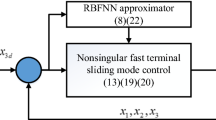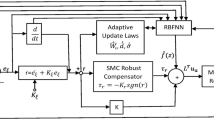Abstract
In this paper, a new constrained error variable similar to sliding mode surface (SMC) is proposed to ensure a prescribed position tracking performance of a robot manipulator. A decentralized controller using this constrained error variable and a radial basis function network (RBF) is designed. The proposed decentralized and constrained control system ensures a prescribed transient and steady-state time positioning performance of the decentralized manipulator components without violation of the prescribed performance. The effectiveness of the proposed decentralized and robust control scheme was determined by comparing the results of simulated and experimental evaluation with the conventional SMC and finite-time terminal SMC methods.
Similar content being viewed by others
References
R. M. DeSantis, “Motion/force control of roboticmanipulators,” Trans. ASME, vol. 118, pp. 386–389, 1996.
Z. P. Wang, S. S. Ge, and T. H. Lee, “Robustmotion/force control of uncertain holonomic/nonholonomic mechanical systems,” IEEE/ASMCTrans. Mehca, vol. 9, no. 1, pp. 118–123, 2004.
A. Ilchman and H. Schuster, “Tracking control withprescribed transient behavior degree,” Sys. & Contr.Letters, vol. 55, pp. 396–406, 2006.
C. P. Benchlioulis and G. A. Rovithakis, “Robustadaptive control of feedback linearizable MIMOnonlinear systems with prescribed performance,” IEEE Trans. on Automatic Control, vol. 53, no. 9, pp. 2090–2099. 2008.
K. P. Tee, S. S. Ge, and E. H. Tay, “Barrier Lyapunovfunctions for the output-constrained nonlinearsystems,” Automatica, vol. 45, no. 4, pp. 918–927, 2009.
Y. Yang, M. Tomizuka, G. Guerreo, and G. Montemayor, “Decentralized robust control of mechanicalsystems,” IEEE Trans. on Automatic Control, vol. 45, no. 4, pp. 771–776, 2000.
C. Lin, A. B. Rad, and W. L. Chan, “An intelligentlongitudinal controller for application insemiautonomous vehicles,” IEEE Trans. Ind.Electron., vol. 57, no. 4, pp. 1487–1497, April 2010.
R. J. Lian, “Adaptive self-organizing fuzzy slidingmoderadial basis-function neural networkcontroller for robotic systems,” IEEE Trans. Ind.Electron., vol. 61, no. 3, pp. 1493–1503, March 2014.
N. Hung, T. D. Viet, J.-S. Im, H.-H. Kim, and S.-B. Kim, “Motion control of an omnidirectional mobileplatform for trajectory tracking using an integralsliding mode controller,” International J. Control,Autom. and Sys., vol. 8, no. 6, pp. 1221–1231, 2010.
J. Lian and J. Zhao, “Sliding mode control switched delay systems via hysteresis switching strategy,” International J. Control, Autom. and Sys., vol. 8, no.6, pp. 1171–1178, 2010.
B. S. Park, J. B. Park, and Y.-H. Choi, “Robustformation control of electrically drivennonholonomic mobile robots via sliding modetechnique” International J. Control, Autom. andSys., vol. 9, no. 5, pp. 888–8943, 2011.
Y. Liu, Y. Niu, and Y. Zou, “Sliding mode controlfor uncertain switched systems subject to actuatornonlinearity,” International J. Control, Autom. andSys., vol. 12, no. 1, pp. 57–62, 2014.
Y. Hong, Y. Xu, and J. Huang, “Finite-time controlfor robot manipulator,” System & Contr. Letter, vol. 46, pp. 243–253, 2002.
S. Yu, X. Yu, B. Shirinzadeh, and Z. Man,“Continuous finite-time control for roboticmanipulators with terminal sliding mode,” Automatica, vol. 41, pp. 1957–1964, 2005.
Y.-H. Jo, Y.-H. Lee, and K.-B. Park, “Design ofgeneralized terminal sliding mode control forsecond-order systems,” International J. Control,Autom. and Sys., vol. 8, no. 3, pp. 606–610, 2011.
S. I. Han and J. M. Lee, “Precise positioning ofnonsmooth dynamic systems using fuzzy waveletecho state networks and dynamic surface slidingmode control,” IEEE Trans. Ind. Electron., vol. 60, no. 11, pp. 5124–5136, November 2013.
Humusoft Comp.: ‘MF 624 Multifunction I/O cardmanual’, Czech Republic, 2006
Author information
Authors and Affiliations
Corresponding author
Additional information
Recommended by Associate Editor Seul Jung under the direction of Editor Fuchun Sun.
This work was supported by the National Research Foundationof Korea (NRF) Grant funded by the Korean Government (MSIP)(NRF-2013R1A1A2021174).
Seong-Ik Han received his B.S. and M.S. degrees in Mechanical Engineering from Pusan National University, Busan, Korea, in 1987 and 1989, respectively, and his Ph.D. in Mechanical Design Engineering from Pusan National University, Busan,in 1995. From 1995 to 2009, he was an associate professor of electrical automation of Suncheon First College, Korea. Now he is with the Department of electronic engineering, Pusan National University, Korea. His research interests include intelligent control, nonlinear control, robotic control, vehicle system control, and steel process control.
Jang-Myung Lee received his B.S. and M.S. degree in electronic engineering from Seoul National University, Seoul,Korea, in 1980 and 1982, respectively,and his Ph.D. degree in computer engineering from the University of Southern California, Los Angeles, in 1990. Since 1992, he has been a Professor with Pusan National University, Busan, Korea. He was the Leader of the “Brain Korea 21 Project” of Pusan National University. His research interests include intelligent robotics, advanced control algorithm, and specialized environment navigation/localization. Prof. Lee was the former presidentof the Korean Robotics Society.
Rights and permissions
About this article
Cite this article
Han, SI., Lee, JM. Decentralized neural network control for guaranteed tracking error constraint of a robot manipulator. Int. J. Control Autom. Syst. 13, 906–915 (2015). https://doi.org/10.1007/s12555-014-0132-2
Received:
Revised:
Accepted:
Published:
Issue Date:
DOI: https://doi.org/10.1007/s12555-014-0132-2




